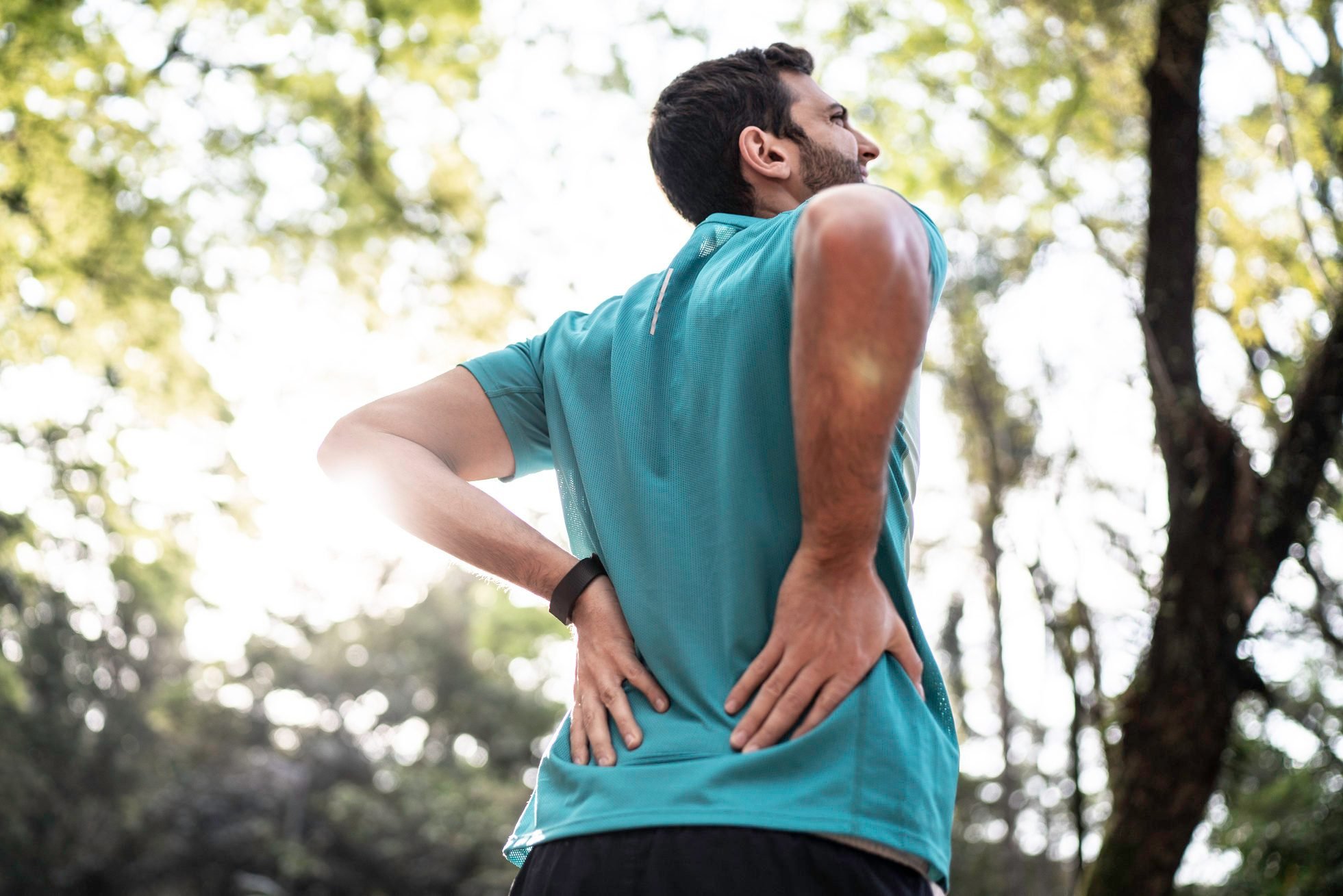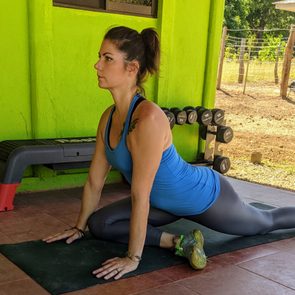What to Do When Walking Causes Lower Back Pain
Updated: Jul. 26, 2024
There are many reasons you may have lower back pain while walking, including these seven conditions. Here's how to prevent and treat back pain simply and quickly.
Our editors and experts handpick every product we feature. We may earn a commission from your purchases.
When walking hurts
Walking is a great thing you can do for your health. Aiming for at least 10,000 steps a day is even better. The benefits for your heart, lungs, and mental health are well-known, but sometimes there can be a downside—lower back pain when walking.
As many as 80% of people in the United States will develop back pain at some point in their lives, making it the third most common reason for doctor visits, according to the American Chiropractic Association.
“Walking or standing for extended periods, can cause strain in the back muscles, especially those that support the lumbar [low back] region, resulting in pain and tension,” explains Gbolahan Okubadejo, MD, a New York City orthopedic surgeon. “This is why long lines can be so stressful. It’s not just impatience; it’s physical strain.”
There are many structures in your back that can cause pain and potentially be triggered by walking, including muscles, tendons, ligaments, nerves, bones, and joints. If you have bad posture or are overweight or obese, you may be at greater risk for back pain while walking. Back pain can be acute (lasting 4 to 12 weeks) or chronic (lasting 12 weeks or more), the Centers for Disease Control and Prevention (CDC) explains.
Read on for the reasons you can get lower back pain when walking.
3 Mid-Back Stretches to Help Ease Back Pain

Muscle fatigue
If you’re overweight or obese, you are more likely to experience back pain when walking, and this is due to muscle fatigue.
Causes
Your lower back carries most of your body’s weight when you walk. It’s not always easy to carry extra pounds, and as a result, your muscles can get worn down. This may cause pain with prolonged standing or walking, says Dr. Okubadejo.
Symptoms
Your back may ache when you are walking or standing, but the pain likely subsides when you sit or lie down.
15 Everyday Habits That May Hurt Your Spine
Diagnosis and treatment
Your doctor will perform a physical exam and may order imaging tests to see what is causing your back pain. “Most back pain is nonspecific, meaning we can’t find an identifiable structure that is causing your pain,” says Jake Magel, PhD, a physical therapist and research assistant professor at the University of Utah in Salt Lake City.
If your weight appears to be causing muscle fatigue and pain when walking, weight loss is the solution. “Weight loss will make a big difference in walking-related back pain,” Dr. Okubadejo says. Exercises to strengthen muscles will also help build the muscles that support your back, he says. Hot or cold therapy, over-the-counter (OTC) nonsteroidal anti-inflammatory drugs (NSAIDs), such as ibuprofen and naproxen, can also aid an achy back.
Got Back Pain? 5 Exercises That Can Make It Better
Sciatica
Sciatica occurs when there is damage to, pressure on, or inflammation of your sciatic nerve, which runs from your lower back through your hips and buttocks, down your legs, and into your feet
Causes
If your sciatic nerve is pinched or compressed due to your gait, it can cause pain, numbness, or weakness up and down your leg, explains Jordan D. Metzl, MD, a sports medicine physician at the Hospital for Special Surgery in New York City and author of several books, including Dr. Jordan Metzl’s Running Strong: The Sports Doctor’s Complete Guide to Staying Healthy and Injury-Free for Life.
Other back problems, such as spinal stenosis (more on that below) or herniated discs, can result in sciatic pain, he says. With the latter condition, one of the discs that serve as shock absorbers between each vertebra may slip or herniate, putting pressure on your sciatic nerve. This may happen with age, or from a strain or twisting movement, Dr. Metzl says.
10 Signs Your Upper Back Pain Is Serious
Symptoms
Sciatica may cause burning, tingling, numbness, radiating pain, or electric shock-like sensations, Dr. Metzl says.
Diagnosis and treatment
Your doctor will ask about the pain and when it first started and will conduct an exam to identity the pinched nerve. Sometimes X-rays or other imaging tests can help confirm the presence and location of the compressed nerve.
Physical therapy, NSAIDs, and sometimes steroid injections may help relieve this pain, Dr. Metzl says.
8 Expert-Approved Home Remedies for Back Pain
Spinal stenosis
Spinal stenosis is a narrowing of the spine that can place extra pressure on the spinal cord and nerves.
Causes
Your risk of developing spinal stenosis increases with advancing age. Osteoarthritis, the wear-and-tear form of arthritis, may also contribute to the narrowing of your spine. (These are the everyday habits that are damaging your spine.)
Symptoms
Spinal stenosis doesn’t always cause symptoms, but it can make walking painful. Classic symptoms are leg pain with walking that is relieved quickly by sitting down. If there is pressure on your sciatic nerve as a result of the narrowing, you may experience pain, numbness, tingling, and other symptoms that can affect your ability to walk too.
Diagnosis and treatment
Your doctor will perform a thorough physical exam that includes feeling your back and asking you to bend forward, backward, and side to side. Imaging tests may also be needed. Treatment typically includes physical therapy and taking NSAIDs, followed by steroid injections if OTC pain relievers don’t do the trick. Surgery is considered a last resort for spinal stenosis.
6 Stretches for Lower Back Pain
Strains and sprains
A sprain is an injury or tear to a ligament that connects two or more bones at a joint, while a strain is an injury to a muscle or tendon.
Causes
If your gait is off, the resulting abnormal movement can cause a strain or sprain in your back. This can also occur if you fall or twist suddenly while you are walking. If you are overweight, you are at higher risk of developing lower back sprains and strains.
Symptoms
Sprains and strains can cause pain, swelling, bruising, cramping, spasms, and/or trouble moving.
Diagnosis and treatment
Your doctor will ask you questions about your pain and when it first started, examine the area, and possibly order X-rays to rule out any broken bones. In general, staying active, taking NSAIDs, and participating in physical therapy will relieve lower back pain from strains and sprains. A gait evaluation by a physical therapist, biomechanical specialist, or kinesiologist, followed by changes to how you walk, may help stave off future sprains and strains.
5 Yoga Poses to Try for Lower Back Pain
Muscle spasms
A sudden, involuntary contraction or twitch in one or more of your muscles is known as a spasm.
Causes
If there is increased pressure on your spine, your lower back muscles may tighten and spasm, leading to pain, says Dr. Metzl. This could occur when you are walking, especially if you accidentally step into a pothole or are yanked by your dog when a squirrel darts across your path.
Symptoms
Muscle spasms come on quickly and often go away just as quickly, he says.
Diagnosis and treatment
Tell your doctor about your pain and when it tends to occur. You may need some imaging tests as well. As with other types of low back pain, staying active, taking NSAIDs, and taking part in physical therapy can usually help muscle spasms. Heating pads can help relax muscle spasms.
16 Ways to Get Rid of Lower Back Pain for Good
Lordosis
This is the medical name for a C-shaped curve in your lower back
Causes
Lordosis can be caused by the brittle bone disease osteoporosis, obesity, and spinal injuries.
Symptoms
Lordosis affects your posture and may lead to pain while you are walking.
Diagnosis and treatment
Your doctor will perform a physical exam to determine if there are any abnormalities in how and where your spine curves. You will likely need X-rays too. Treatment may include medication, physical therapy, weight loss, and possibly bracing. If osteoporosis is the cause, your doctor may suggest medications to help preserve your bone.
What Causes Sharp Lower Back Pain?
Poor posture
Poor posture can cause you to hunch forward when you walk.
Causes
There are many potential causes of poor posture, including stress, obesity, pregnancy, weak core muscles, tight muscles, high-heels, and improper sitting at your workstation.
Symptoms
Poor posture can place increased pressure on your backbone. This, in turn, can affect your muscles, discs, joints, and nerves, causing pain and possibly sciatica.
Diagnosis and treatment
If your posture is responsible for back pain while walking, a doctor, chiropractor, or physical therapist can suggest exercises to strengthen your core and improve your posture. As a general rule, “Don’t slump, hunch, or lean too far forward,” says Dr. Okubadejo.
Lifestyle interventions
Losing weight if you are overweight or obese is one of the best ways to reduce your chances of developing back pain while walking, according to Dr. Okubadejo. “Keeping a healthy weight can also reduce stress on the back and legs,” he says.
“Consume a healthy, balanced diet that includes lean protein, fruit, whole grains, and vegetables,” says Dr. Okubadejo. “Light and slow exercises can loosen and stretch tight muscles,” he says.
Hot or cold therapy and NSAIDs are also helpful. “When your back pain is acute [less than a four-week period)] and/or occurs due to a direct injury, use cold therapy first, as lowering the body temperature will help constrict the blood vessels, reduce swelling, decrease inflammation, and cause a numbing effect,” Dr. Okubadejo says.
Once the inflammation has subsided, use heat therapy. “When you apply heat, it improves the flexibility of soft tissues, movement of muscles, and overall functioning of the back,” he explains. “The warmth stimulates blood circulation in your lower back, which in turn brings healing nutrients to the injured tissues.”
9 Secret Reasons You Might Have Back Pain
The last word
The benefits of walking far outweigh any risks. If your back hurts while you are walking, talk to a doctor or physical therapist to see what is causing your pain and what tweaks you can make to feel better and reap the benefits of walking.























